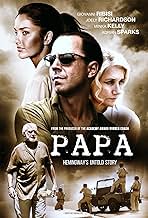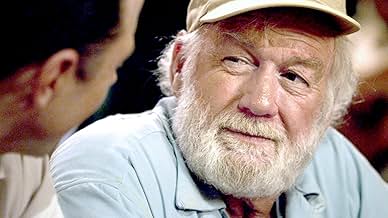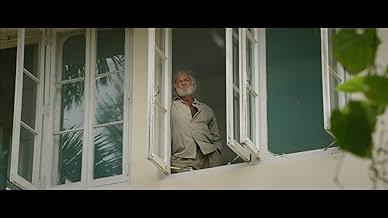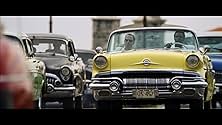IMDb-BEWERTUNG
6,3/10
1765
IHRE BEWERTUNG
Füge eine Handlung in deiner Sprache hinzuIn 1959, a young journalist ventures to Havana, Cuba to meet his idol, the legendary Ernest Hemingway who helped him find his literary voice, while the Cuban Revolution comes to a boil aroun... Alles lesenIn 1959, a young journalist ventures to Havana, Cuba to meet his idol, the legendary Ernest Hemingway who helped him find his literary voice, while the Cuban Revolution comes to a boil around them.In 1959, a young journalist ventures to Havana, Cuba to meet his idol, the legendary Ernest Hemingway who helped him find his literary voice, while the Cuban Revolution comes to a boil around them.
- Regie
- Drehbuch
- Hauptbesetzung
- Auszeichnungen
- 2 wins total
Joseph Peréz Bertót
- Roberto Herrara
- (as Joseph Bertót)
Empfohlene Bewertungen
In literature, there is a term called the "Hemingway Hero," which is essentially a set of noble traits and honorable qualities that the reader should aspire to, much like any character in an Ernest Hemingway novel. Every writer attempting to create this attribute will find that the qualities that make up a hero today compared to that of Hemingway's day are consistent and timeless. This idea of what makes a man a man, and living a life of "honor, courage and endurance in a world that is sometimes chaotic, often stressful, and always painful" will forever ring true to those in search of a deeper meaning of life. The Bob Yari-directed film Papa: Hemingway in Cuba, tells the true story of one man's relationship with the legendary writer Ernest Hemingway, and essentially starting his journey to find his own, literal, "Hemingway Hero".
"What do you say to the man who changed your life, and never even knew you?" Ed Myers (Giovanni Ribisi), a journalist at the Miami Herald in the 1950s, asks this question while struggling to find the words for a letter he plans to send to his idol, Ernest Hemingway (Adrian Sparks). Growing up an orphan during the depression, Myers' voice-over explanation reveals that he had always wanted to be a writer and an adventurer. His lack of family ties created a longing for someone to look up to, someone to be a father figure. He writes all of this and more in his letter, spilling his soul onto the page. Then, one day, Myers gets a life-changing phone call from the man himself, telling him how much he appreciated the letter and then asking him to travel to Cuba to spend time with him.
While the first third of the film tends to drag a bit slowly, it really comes alive when we follow Myers to Cuba and get to meet Hemingway. The atmosphere of the city and live music are electrifying, a juxtaposition to the man Hemingway had become by that point in his life. Myers quickly develops a closeness to Hemingway and his wife Mary (Joely Richardson), considering them the family he never had. However, their blissful life erupts into chaos as they immediately find themselves in the middle of the Cuban revolution.
The fact that this is a true story alone is worth watching, but probably the biggest selling point is that this is the first Hollywood film to be shot in Cuba in over 50 years. The authenticity of being able to shoot in the original locations including the bar El Floridito and Hemingway's actually home in Finca Vigia, which is now preserved as a national museum, is a fascinating thing to see. Possibly the coolest memento of all, though, is that the typewriter used in the film is Hemingway's original one.
Personally, a big fan of Hemingway myself, (I did name my dog Ernest after all), seeing this time period in his life is difficult as we all know the outcome of his losing battle with depression. It is a hard pill to swallow watching him stick a revolver in his mouth and beat his wife. For as beautiful the worlds he created in his books, the man we see on screen is a tortured artist that is struggling to see the purpose of his own life. Adrian Sparks captures both Hemingway's brilliance and demons in his performance, truly giving justice and respect to the late author.
As much as you become absorbed in Sparks' performance, there are moments that can take you out of the film. At times Ribisi comes off somewhat flat, for example, getting that initial call from his idol, Hemingway himself, he barely seems to muster up any excitement. Instead, it feels as if that scene may have been rehearsed one too many times and, by that take, he was just going through the motions. Another head scratching moment is how quickly the film jumps into some scenes without much setup. One moment, Myers is on the beach in Cuba, the next he's on the beach in Florida telling his girlfriend (Minka Kelly) about his trip to Cuba. It feels rushed, but at this point, we've become invested in these characters that we're along for the ride so we don't really care where we're going or how we get there.
Papa: Hemingway in Cuba is a stunning portrait of one of the greatest authors and storytellers of the 20th century. Bob Yari takes the biopic and breathes life into the genre just by the sheer amount of authentic details (like the shooting locations alone), plus this inspiring and true story of one man's search for the meaning of life is something we can all relate to. Bonus- Keep an eye out for a quick cameo from Ernest's granddaughter Mariel Hemingway.
For more, visit www.cinemacy.com
"What do you say to the man who changed your life, and never even knew you?" Ed Myers (Giovanni Ribisi), a journalist at the Miami Herald in the 1950s, asks this question while struggling to find the words for a letter he plans to send to his idol, Ernest Hemingway (Adrian Sparks). Growing up an orphan during the depression, Myers' voice-over explanation reveals that he had always wanted to be a writer and an adventurer. His lack of family ties created a longing for someone to look up to, someone to be a father figure. He writes all of this and more in his letter, spilling his soul onto the page. Then, one day, Myers gets a life-changing phone call from the man himself, telling him how much he appreciated the letter and then asking him to travel to Cuba to spend time with him.
While the first third of the film tends to drag a bit slowly, it really comes alive when we follow Myers to Cuba and get to meet Hemingway. The atmosphere of the city and live music are electrifying, a juxtaposition to the man Hemingway had become by that point in his life. Myers quickly develops a closeness to Hemingway and his wife Mary (Joely Richardson), considering them the family he never had. However, their blissful life erupts into chaos as they immediately find themselves in the middle of the Cuban revolution.
The fact that this is a true story alone is worth watching, but probably the biggest selling point is that this is the first Hollywood film to be shot in Cuba in over 50 years. The authenticity of being able to shoot in the original locations including the bar El Floridito and Hemingway's actually home in Finca Vigia, which is now preserved as a national museum, is a fascinating thing to see. Possibly the coolest memento of all, though, is that the typewriter used in the film is Hemingway's original one.
Personally, a big fan of Hemingway myself, (I did name my dog Ernest after all), seeing this time period in his life is difficult as we all know the outcome of his losing battle with depression. It is a hard pill to swallow watching him stick a revolver in his mouth and beat his wife. For as beautiful the worlds he created in his books, the man we see on screen is a tortured artist that is struggling to see the purpose of his own life. Adrian Sparks captures both Hemingway's brilliance and demons in his performance, truly giving justice and respect to the late author.
As much as you become absorbed in Sparks' performance, there are moments that can take you out of the film. At times Ribisi comes off somewhat flat, for example, getting that initial call from his idol, Hemingway himself, he barely seems to muster up any excitement. Instead, it feels as if that scene may have been rehearsed one too many times and, by that take, he was just going through the motions. Another head scratching moment is how quickly the film jumps into some scenes without much setup. One moment, Myers is on the beach in Cuba, the next he's on the beach in Florida telling his girlfriend (Minka Kelly) about his trip to Cuba. It feels rushed, but at this point, we've become invested in these characters that we're along for the ride so we don't really care where we're going or how we get there.
Papa: Hemingway in Cuba is a stunning portrait of one of the greatest authors and storytellers of the 20th century. Bob Yari takes the biopic and breathes life into the genre just by the sheer amount of authentic details (like the shooting locations alone), plus this inspiring and true story of one man's search for the meaning of life is something we can all relate to. Bonus- Keep an eye out for a quick cameo from Ernest's granddaughter Mariel Hemingway.
For more, visit www.cinemacy.com
"Papa: Hemingway in Cuba" (2016 release; 109 min.) brings the story of a young journalist's friendship with and mentorship by Ernest Hemingway in Cuba in the late 50s. As the movie opens, we are in "Seattle 1935", where the then 4 year old boy is abandoned by his father in the middle of a department store. We then flash forward to "Miami Globe 1957", where we get to know the journalist Ed Myers. He finally sends a letter to Hemingway to express how much Hemingway's writings inspired Myers in his darkest hours. Much to Myers' surprise, some time later Hemingway calls and invites him to visit him in Cuba, and so off to Cuba goes Myers. At this point we're not even 15 minutes into the movie, but to tell you more would spoil your viewing experience, you'll just have to see for yourself how it all plays out.
Couple of comments: first, all of the marketing materials regarding this movie list this as "Papa: Hemingway in Cuba", but in the movie itself, it's simply announced as "Papa: A True Story" ("Papa" is of course Hemingway's nickname). Second, this movie is written by Denne Bart Petitclerc, the actual journalist to whom this happened (I figure he changed the name to Ed Myers as, let's face it, his real name is more than a mouthful). Third, this is directed (in his directing debut) by long-time producer Bob Yari. Yari brings the story aptly but without any real surprises or revelations, it's as if he is directing "by the numbers". As you may surmise, given that the story is set in the late 50s, the movie is a mix of observing Hemingway the person, and also seeing how the revolution is playing out in the background. The cast is just okay, with the previously unknown (to me anyway) Adrian Sparks in the Hemingway role. Keep your eyes open for a quick cameo by Mariel Hemingway, the real life granddaughter and erstwhile 'buzz' actress herself. Minka Kelly plays a nice secondary role (as Myers' girlfriend). But you know who is the real star of this movie? That would be the location where much of this was filmed, namely the sprawling Hemingway estate (called Finca Vigía) in Cuba, where Hemingway lived for many years, and which nowadays is the Hemingway national museum in Cuba. Looks to be an amazing place, at least when seeing it on the big screen. Last but not least, there is a nice orchestral score, composed by Mark Isham. Bottom line: this movie has its pros and cons, and its good moments and not-o-good moments. Still, I found myself enjoying this more or less, hence a mixed rating of 3 stars.
"Papa" opened recently at my local art-house theater here in Cincinnati. The Sunday early evening screening where I saw this at this past weekend was attended okay (better than I expected, frankly), and fairly heavy on the seniors side. If you like a historical drama involving some big personalities, "Papa" is worth checking out, be it in the theater, on VOD, or eventually on DVD/Blu-ray.
Couple of comments: first, all of the marketing materials regarding this movie list this as "Papa: Hemingway in Cuba", but in the movie itself, it's simply announced as "Papa: A True Story" ("Papa" is of course Hemingway's nickname). Second, this movie is written by Denne Bart Petitclerc, the actual journalist to whom this happened (I figure he changed the name to Ed Myers as, let's face it, his real name is more than a mouthful). Third, this is directed (in his directing debut) by long-time producer Bob Yari. Yari brings the story aptly but without any real surprises or revelations, it's as if he is directing "by the numbers". As you may surmise, given that the story is set in the late 50s, the movie is a mix of observing Hemingway the person, and also seeing how the revolution is playing out in the background. The cast is just okay, with the previously unknown (to me anyway) Adrian Sparks in the Hemingway role. Keep your eyes open for a quick cameo by Mariel Hemingway, the real life granddaughter and erstwhile 'buzz' actress herself. Minka Kelly plays a nice secondary role (as Myers' girlfriend). But you know who is the real star of this movie? That would be the location where much of this was filmed, namely the sprawling Hemingway estate (called Finca Vigía) in Cuba, where Hemingway lived for many years, and which nowadays is the Hemingway national museum in Cuba. Looks to be an amazing place, at least when seeing it on the big screen. Last but not least, there is a nice orchestral score, composed by Mark Isham. Bottom line: this movie has its pros and cons, and its good moments and not-o-good moments. Still, I found myself enjoying this more or less, hence a mixed rating of 3 stars.
"Papa" opened recently at my local art-house theater here in Cincinnati. The Sunday early evening screening where I saw this at this past weekend was attended okay (better than I expected, frankly), and fairly heavy on the seniors side. If you like a historical drama involving some big personalities, "Papa" is worth checking out, be it in the theater, on VOD, or eventually on DVD/Blu-ray.
This true story about the relationship between journalist Denne Bart Petitclerc (Giovanni Ribisi) and legendary writer Ernest Hemingway (Adrian Sparks) takes place during the 1959 Cuban Revolution. While Hemingway's granddaughter, Mariel Hemingway gets a brief cameo, co-stars Minka Kelly (Friday Night Lights), Joely Richardson (Nip/Tuck) and Ribisi are left to fight to establish their place in the film. To blame here is Director Bob Yari ("Crash" 2004) and Editor Glen Scantlebury. With a beach scene between Hemingway, Mary and Denne incorrectly shot/edited (the beach shore can't be behind all of them) and scenes that stop and start, the already lackluster chemistry between the characters struggle. Even Writer Denne Bart Petitclerc's dialogue is choppy and weak, and this is his story. At least, Sparks does a nice job as Hemingway, providing something interesting to hang on to. I don't care if this is the first Hollywood film to be shot in Cuba since 1959, I need more here and didn't get it.
I can't say this is a great movie, but I don't know why the critics were so hard on it - currently 8% on by Metacritic professional critics. Hemingway had a long and adventuresome life, and this movie captures the last year he spent at his Cuban estate, Finca Vigia. The beautiful, sprawling, gated estate had been a source of comfort for Hem through two divorces, multiple wars, and the withering of his talent. By 1959, Hem's cumulative emotional distress is mirrored in Cuba's political unrest, and the film captures that quite perfectly.
Giovanni Ribisi as Hemingway's new, young writer friend is more toned down that he is in other amped-up roles, and Adrian Sparks effectively becomes Hemingway; it's hard to believe it isn't him in many scenes. Joely Richardson was a terrific foil, moving through the turbulence of their marriage minute by minute, showing the deep love she had for him but also the anger she had at his drunken antics.
The film had some very nice touches, like the poly-dactyl cat in a very brief scene; Hemingway loved poly-dactyls in his later years.
I felt the movie was fairly well-paced and beautifully filmed. The drama around -- no spoilers -- some government issues was a little out of left field tone-wise, but otherwise I found it a rather lovely little picture, an admirable tribute to a great writer and a flawed man with a lasting legacy.
Giovanni Ribisi as Hemingway's new, young writer friend is more toned down that he is in other amped-up roles, and Adrian Sparks effectively becomes Hemingway; it's hard to believe it isn't him in many scenes. Joely Richardson was a terrific foil, moving through the turbulence of their marriage minute by minute, showing the deep love she had for him but also the anger she had at his drunken antics.
The film had some very nice touches, like the poly-dactyl cat in a very brief scene; Hemingway loved poly-dactyls in his later years.
I felt the movie was fairly well-paced and beautifully filmed. The drama around -- no spoilers -- some government issues was a little out of left field tone-wise, but otherwise I found it a rather lovely little picture, an admirable tribute to a great writer and a flawed man with a lasting legacy.
A very generous story, beautiful acting and fair portrait of Ernest Hemingway. A film to remind not exactly a biography but the small, essential things defining, in proper manner, the life.
A film about admiration, friendship, fame, marriage and fall of apparences and old stories .
Just admirable crafted and, for the work of Adrian Sparks being pure grateful.
A film about admiration, friendship, fame, marriage and fall of apparences and old stories .
Just admirable crafted and, for the work of Adrian Sparks being pure grateful.
Wusstest du schon
- WissenswertesFirst American film to be shot in Cuba in over 50 years.
- PatzerThe characters of Ernest Hemingway and Ed Myers are wearing Ray Ban sunglasses with the logo on the lens. Ray Bans did not put logos on the lenses until 1982.
- Zitate
Ernest Hemingway: The only value we have as human beings are the risks we're willing to take.
Top-Auswahl
Melde dich zum Bewerten an und greife auf die Watchlist für personalisierte Empfehlungen zu.
- How long is Papa Hemingway in Cuba?Powered by Alexa
Details
- Erscheinungsdatum
- Herkunftsländer
- Offizieller Standort
- Sprache
- Auch bekannt als
- Papa
- Drehorte
- Produktionsfirmen
- Weitere beteiligte Unternehmen bei IMDbPro anzeigen
Box Office
- Bruttoertrag in den USA und Kanada
- 1.115.615 $
- Eröffnungswochenende in den USA und in Kanada
- 475.224 $
- 1. Mai 2016
- Weltweiter Bruttoertrag
- 1.153.690 $
- Laufzeit
- 1 Std. 50 Min.(110 min)
- Farbe
- Sound-Mix
- Seitenverhältnis
- 2.39:1
Zu dieser Seite beitragen
Bearbeitung vorschlagen oder fehlenden Inhalt hinzufügen




































